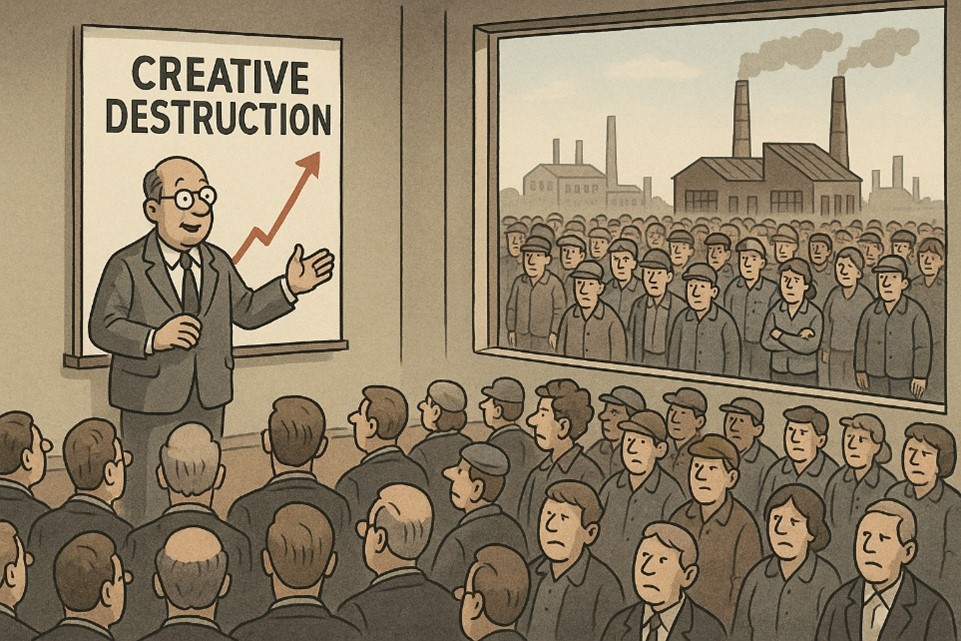



When the world mistakes disruption for destiny
By Ravishankar Kalyanasundaram
A Nobel That Became a Narrative
The 2025 Nobel in economics may have honoured an important stream of thought — but we must resist treating it as holy writ. Not every elegant equation deserves a moral halo.
The task of economics is not merely to model how disruption works, but to show how societies can navigate it humanely. The world does not need another mathematical proof that old things break and new ones emerge. It needs guidance on how to make transitions smoother, fairer, and less cruel.
We see the proof of abstraction everywhere. From Apple’s annual upgrades that turn last year’s phones into landfill to the churn of AI start-ups replacing workers faster than they can retrain, “creative destruction” has become the moral vocabulary of excess. Innovation dazzles, but its detritus piles up — in oceans, in minds, and in the unemployed.
The Mythic Weight of Big Ideas
Some ideas — especially those about capitalism and progress — carry mythic weight. The Nobel Prize confers legitimacy that shapes budgets, textbooks, and ideology. When a prize elevates a theory of disruption, it subliminally suggests that destruction is necessary, virtuous, even inevitable. But what of the losers — displaced workers, stranded capital, communities locked out of transitions?
Global debt now exceeds $315 trillion, three-and-a-half times world GDP. If nations had lived within their means, the world might have traded speed for stability and efficiency for equity. In chasing growth, governments mortgaged prudence — and people mortgaged tomorrow.
The Credit-Card Civilisation
Much of this debt is not the burden of survival but the cost of spectacle. The modern economy thrives less on need than on novelty — a credit-card civilisation funding gratification rather than growth. These borrowings were rarely for bread or education; they were for lifestyles scripted by innovation itself — the next phone before the battery dies, the car before the road improves, the screen before the story ends.
What we call creative destruction may in truth be conspicuous consumption dressed as progress, a cycle where obsolescence sustains the illusion of prosperity.
The Forgotten Economics of Gandhi
Mahatma Gandhi, trained as a barrister in British law, saw early that an economy cannot live on arithmetic alone. His village-centric model was not romanticism; it was realism for a nation where labour was the only abundant capital. By discarding that wisdom, India — like much of the modern world — created migration without mobility, glittering cities surrounded by shadows. The myth of development replaced the meaning of livelihood.
The Doctrine of Replacement
The laureates of this year’s Nobel write that “each innovation destroys the monopoly power of its predecessor.” It sounds tidy. But outside the equations, replacement is never so clean. Old technologies are not just machines; they are jobs, towns, and cultures. For every “efficient” factory automation builds, a township loses its rhythm. For every algorithm that predicts demand, a craftsman loses relevance. The spreadsheet calls it productivity; the worker calls it redundancy.
When description turns into doctrine, replacement becomes policy. Governments start believing that faster turnover equals progress, and that every dismantled system proves modernization. Thus a classroom model becomes a cabinet mantra.
From Model to Mantra
Once a theory wins a Nobel, it travels fast — quoted in policy papers, echoed at investor summits, whispered in budget speeches as gospel truth. In an age when slogans outpace scrutiny, “move fast and break things” becomes theology. But a civilisation that celebrates breaking more than building soon learns the cost of its cleverness.
History offers reminders. Britain’s 1980s privatizations boosted efficiency on paper but left mines shut and communities hollowed. Across Latin America in the 1990s, deregulation sold as “creative destruction” delivered shuttered factories and social unrest. The invisible hand that was to rebalance the system remained invisible — not because it was mystical, but because it was missing.
The Real Costs of Obsolescence
Every disruption carries a cost somewhere. When industries die faster than new ones mature, when workers are displaced before they can reskill, societies incur losses seldom booked in growth ledgers.
Nature bears the cost too. E-waste mountains in Ghana, lithium pits in Bolivia, and dying rivers in Asia are collateral damage of perpetual replacement. We call it innovation; the Earth calls it exhaustion.
A mature economy must therefore learn to price destruction as carefully as it prices creation. The cost of obsolescence is not merely financial; it is social, cultural, and psychological. Progress is not how many industries we discard, but how gently we let them go.
The Missing Half of the Nobel Story
The Nobel committee is right to celebrate the elegance of innovation-driven growth. Yet in doing so, it risks sanctifying disruption while ignoring continuity. The real world is not a frictionless lab. It is full of lock-ins, institutions, and inertia. The coder depends on the teacher; the electric car on the coal-built grid; the new on the old. Progress is not always destruction; sometimes it is renovation.
A More Humane Horizon
Disruption, when managed well, can renew economies. Unmanaged destruction breeds despair — the very force now unsettling democracies from Manchester to Montevideo.
Perhaps the next great economic insight will not model how things fall apart but how they hold together: how societies rebuild trust, retrain labour, and repurpose what they already have.
The real task ahead is not to glorify disruption but to design inclusion — to make growth feel shared, not imposed; human, not statistical.
The next enlightenment may not come from a start-up or a Nobel seminar, but from a society that learns to repair before it replaces.